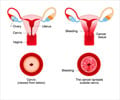Causes for genetic disorders
Genetic disorders are caused by changes in the structure or number of the chromosomes or in the DNA
Genetic problems arise due to different reasons:
DNA and GENES: The DNA, is a unique, spiral- shaped molecule found in all living cells. It is called the ‘blue print of life’ and controls the existence of most creatures on earth. A specific segment of the DNA that codes for specific body proteins is called the gene. The DNA and the genes are compactly arranged on the chromosomes.
Genes encodes for proteins some of which, such as enzymes, carry out significant life functions. There are no genes that actually cause a disease. Changes in the genes called mutations, alter the structure function of the gene products which gives rise to diseases. A mutation in a single gene may result in a serious disorder like cystic fibrosis, achondroplasia or sickle cell anemia.
Researchers have identified several oncogenes or cancer- causing genes in the humans. A mutation in one of these oncogenes results in cancer in an individual. A classical example is a mutation in the oncogenes BRCA that increases the susceptibility of breast cancer by 85% and ovarian malignancy by 50% in women.
Sometimes a mutation in the genes on the sex chromosomes results in a disorder. Mutations in certain X-linked genes result in specific diseases like Hemophilia, Muscular dystrophy and Fragile X syndrome. The most common type of ectodermal dysplasia, hypohidrotic ectodermal dysplasia (HED) is caused by a mutation in the ectodysplasin-A (EDA) gene. Women are often only carriers of these X-linked disorders as they have two copies of the X chromosomes. Men, on the other hand, are affected as they have only a single X chromosome. Deletion of certain Y-linked genes, like the SRY, result in infertility in men.
Chromosomes: Humans have 46 chromosomes, arranged as 23 pairs, in each cell. Each chromosome of a pair is inherited from each of the parent.
An error may occur in the cell division either before or after embryo formation. The embryo will then have decreased or increased number of chromosomes. For eg, a Down syndrome individual has three copies of chromosome 21 when there should only be two. This condition is called a trisomy. Edward’s syndrome (trisomy 18) and Patau’s syndrome (trisomy 13) are the other examples. Down syndrome is the most common of all the trisomy and has a fairly good life expectancy. The rate of survival for the other trisomies is, rather poor. When a single copy of a chromosome is present it is known as monosomy. Survival is not known as it results in abortions or stillbirth.
Some genetic conditions also occur as a result of the sex chromosomes being more or less in number. A male has a X and a Y chromosome while the female has two XX. Sometimes a female has only a single X chromosome. This results in a Turner’s syndrome.Sometimes a male can have extra numbers of X chromosome causing Klinefelter syndrome in the affected individuals.
In certain cases the number of chromosomes may be intact, but a part of the chromosome will be missing. This is called a deletion, which will result in the loss of a single gene or a few genes. Classical disorders caused by a deletion are the Cri-du-chat or the ‘cat-cry’ syndrome, Di George syndrome and William syndrome. Translocations occur when parts of the chromosomes get transferred from one chromosome to the other. Inversions, on the other hand result when parts of the chromosomes get deleted and get inverted to get re-inserted again. Translocations and Inversions do not cause malformations. They may cause later life complications like infertility or miscarriages.







